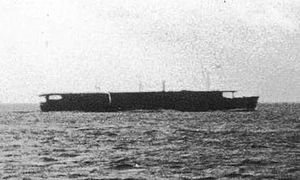Japanese aircraft carrier Unyo

Un'yō in military service in 1943
|
|
| History | |
|---|---|
|
|
|
| Name: | Yawata Maru |
| Operator: |
|
| Builder: | Mitsubishi Shipbuilding & Engineering Co., Nagasaki, Japan |
| Yard number: | 751 |
| Laid down: | 14 December 1938 |
| Launched: | 31 October 1939 |
| Completed: | 31 July 1940 |
| In service: | 1940 |
| Fate: | Transferred to the Imperial Japanese Navy, 1941 |
|
|
|
| Commissioned: | 31 May 1942 |
| Out of service: | 17 September 1944 |
| Renamed: | Un'yō, 31 August 1942 |
| Fate: | Sunk by the submarine USS Barb, 17 September 1944 |
| General characteristics (as converted) | |
| Class and type: | Taiyō-class escort carrier |
| Displacement: |
|
| Length: | 180.2 m (591 ft 4 in) (o/a) |
| Beam: | 22.5 m (73 ft 10 in) |
| Draft: | 7.7 m (25 ft 5 in) |
| Installed power: |
|
| Propulsion: |
|
| Speed: | 21 knots (39 km/h; 24 mph) |
| Range: | 6,500 or 8,500 nmi (12,000 or 15,700 km; 7,500 or 9,800 mi) at 18 knots (33 km/h; 21 mph) |
| Complement: | 850 |
| Armament: |
|
| Aircraft carried: | 30 |
Un'yō (雲鷹? Cloud Hawk) was a Taiyō-class escort carrier originally built as Yawata Maru (八幡丸?), one of three Nitta Maru-class cargo liner built in Japan during the late 1930s. She was transferred to the Imperial Japanese Navy (IJN) during the Pacific War and was converted into an escort carrier in 1942. She spent most of her service ferrying aircraft, cargo and passengers to various bases in the Pacific until she was sunk by an American submarine in 1944.
Yawata Maru was the second of three ships of the Nitta Maru-class and was built by Mitsubishi Shipbuilding & Engineering Co. at their Nagasaki shipyard for Nippon Yusen Kaisha (NYK). She was laid down on 14 December 1938 as yard number 751, launched on 31 October 1939 and completed on 31 July 1940. The IJN subsidized all three Nitta Maru-class ships for possible conversion into auxiliary aircraft carriers. The ships were intended for service to Europe, but the start of World War II in September 1939 restricted them to the Pacific.
The 17,163-gross register ton (GRT) vessel had a length of 170.0 meters (557.8 ft), a beam of 22.5 meters (73.8 ft) and a depth of hold of 12.4 meters (40.7 ft). She had a net tonnage of 9,379. The ship was powered by two sets of geared steam turbines, each driving one propeller shaft, using steam produced by four water-tube boilers. The turbines were rated at a total of 25,200 shaft horsepower (18,800 kW) that gave her an average speed of 19 knots (35 km/h; 22 mph) and a maximum speed of 22.2 knots (41.1 km/h; 25.5 mph).
...
Wikipedia
